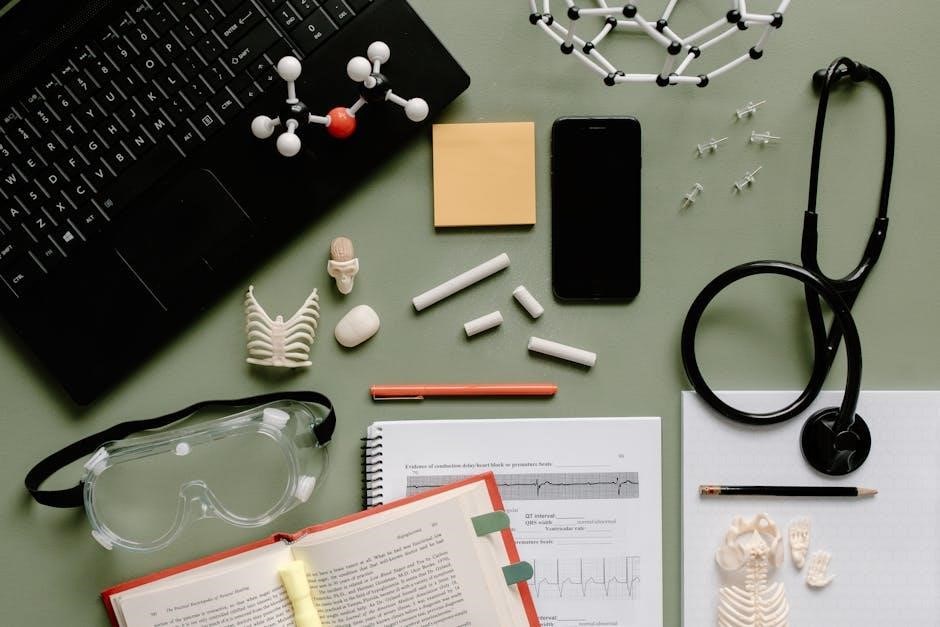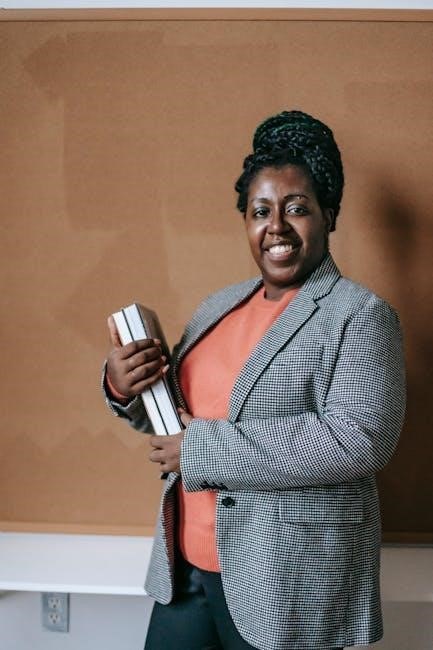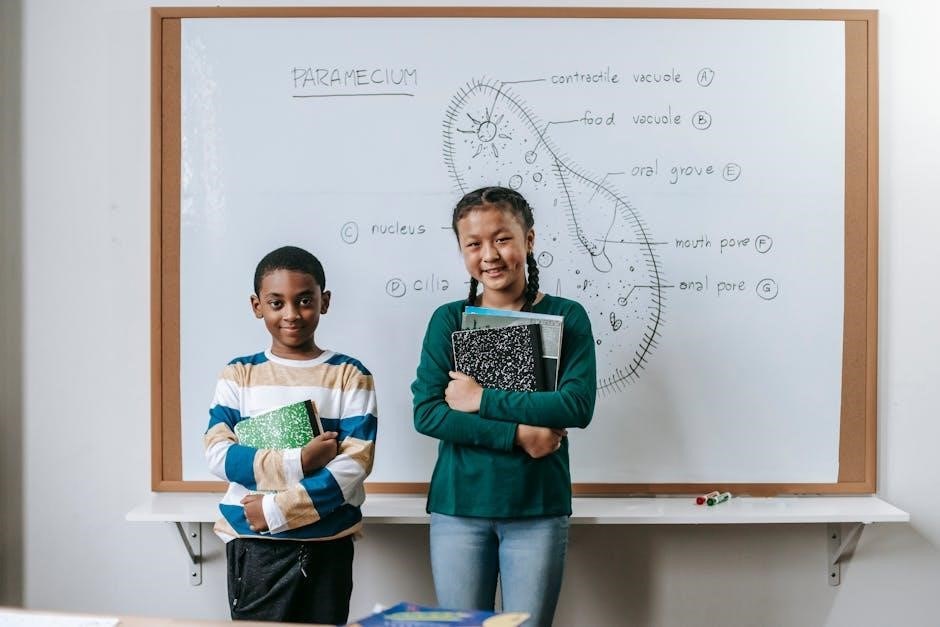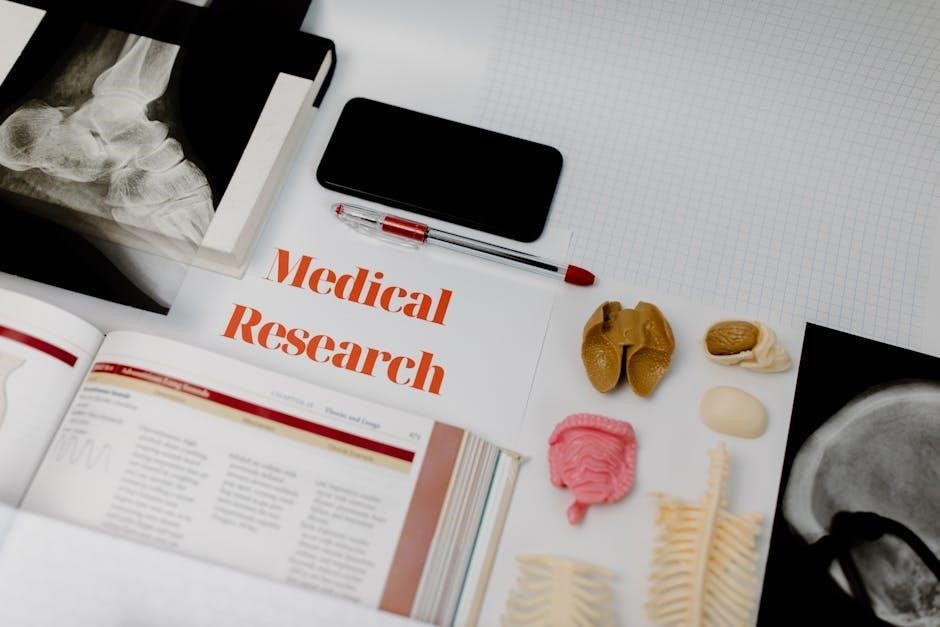Overview of the Year 7 Science Curriculum
Year 7 Science introduces foundational concepts in biology, chemistry, physics, and Earth sciences. The curriculum focuses on building scientific literacy and critical thinking skills. Free PDF textbooks provide accessible resources for learning, aligning with curriculum standards and offering engaging visuals and practical exercises to enhance understanding.
Year 7 Science is a foundational course that introduces students to key concepts in biology, chemistry, physics, and Earth sciences. It focuses on developing scientific literacy and critical thinking skills through engaging lessons. The curriculum is designed to spark curiosity and prepare students for future studies. With the availability of free PDF textbooks, students can access comprehensive resources that align with curriculum standards. These textbooks often include practical exercises, visuals, and interactive elements to enhance learning. This introduction sets the stage for a broad understanding of scientific principles and their real-world applications, making science accessible and enjoyable for young learners.
1.2 Key Concepts and Skills
Year 7 Science focuses on key concepts such as cells, tissues, and organs, as well as unicellular and multicellular organisms. Students explore ecosystems, interactions, and the structure of matter. They learn about elements, compounds, and mixtures, along with chemical reactions. In physics, forces, motion, energy, sound, and light are introduced. Earth sciences cover the planet’s structure, rocks, minerals, and processes like weathering. Skills developed include critical thinking, scientific inquiry, and problem-solving. Practical exercises and investigations enhance understanding, preparing students for further studies and fostering a deeper appreciation of scientific principles and their applications.
1.3 Importance of Scientific Literacy
Scientific literacy is essential for Year 7 students to understand the world around them. It fosters critical thinking, problem-solving, and informed decision-making. By studying science, students gain insights into real-world issues like environmental conservation and technological advancements. Scientific literacy empowers individuals to evaluate evidence, question assumptions, and engage in meaningful discussions. It also prepares students for future careers in STEM fields. The curriculum emphasizes the development of these skills through engaging resources, including PDF textbooks, ensuring students are well-equipped to navigate a rapidly changing world and contribute to societal progress.
Biology in Year 7 Science
Biology introduces students to cells, tissues, and organs, exploring unicellular and multicellular organisms. It also covers ecosystems, interactions, and the structure of living organisms, fostering a deeper understanding of life processes.
2.1 Cells, Tissues, and Organs
In Year 7 Science, students explore the hierarchy of life, starting with cells as the basic units of life. They learn how cells specialize and group into tissues, which form organs. This section emphasizes the structure and function of cells, including unicellular organisms like bacteria and multicellular organisms such as plants and humans. Textbooks provide detailed diagrams and practical exercises to help students understand how tissues and organs work together in systems. This foundational knowledge is essential for grasping broader biological concepts and is supported by interactive resources in PDF formats for deeper engagement.
2.2 Unicellular and Multicellular Organisms
Year 7 Science explores the differences between unicellular and multicellular organisms. Unicellular organisms, like bacteria, consist of a single cell performing all life functions. Multicellular organisms, such as plants and humans, are composed of many cells that specialize and work together. Textbooks detail how cells in multicellular organisms form tissues and organs, enabling complex functions. Practical exercises in PDF resources help students compare these organisms, understanding their structures and interactions within ecosystems. This section builds on cellular biology, providing a foundation for studying life processes and systems in living organisms.
2.3 Ecosystems and Interactions
Year 7 Science textbooks explore ecosystems, focusing on interactions between living organisms and their environments. Students learn about producers, consumers, and decomposers, as well as energy flow through food chains and food webs. The curriculum emphasizes how organisms adapt to their habitats and the impact of human activities on ecosystems. PDF resources include diagrams and activities to study predation, symbiosis, and environmental balance. These materials help students understand the interconnectedness of life and the importance of conservation. Practical exercises encourage observation and analysis of local ecosystems, fostering a deeper appreciation for biodiversity and ecological sustainability.

Chemistry in Year 7 Science
Year 7 Chemistry introduces the study of matter, elements, compounds, and mixtures. Students explore chemical reactions, processes, and practical exercises to understand material properties and transformations.
In Year 7 Chemistry, students explore the basics of matter, including its composition and properties. They learn about elements, compounds, and mixtures, understanding how matter can be classified and transformed. Textbooks provide detailed explanations and practical exercises to reinforce these concepts, ensuring a solid foundation for further study. Resources like the Cambridge Lower Secondary Science Learners Book and Open Educational Resource (OER) textbooks align with curriculum standards, offering interactive and engaging content to help students grasp these fundamental ideas.
3.2 Elements, Compounds, and Mixtures
In Year 7 Chemistry, students learn to distinguish between elements, compounds, and mixtures. Elements are pure substances consisting of one type of atom, while compounds are formed when elements combine in fixed ratios. Mixtures, unlike compounds, contain two or more substances that can be separated. Textbooks like the Cambridge Lower Secondary Science Learners Book provide detailed explanations and practical exercises to help students understand these concepts. Open Educational Resource (OER) textbooks also offer interactive content, such as diagrams and activities, to reinforce learning. These resources align with curriculum standards, ensuring students grasp the fundamentals of chemistry effectively.
3.3 Chemical Reactions and Processes
In Year 7 Chemistry, students explore chemical reactions and processes, learning to identify reactants, products, and the changes that occur. Textbooks like the Cambridge Lower Secondary Science Learners Book explain concepts such as balanced equations and types of reactions, including synthesis and decomposition. Open Educational Resource (OER) textbooks provide interactive diagrams and activities to visualize chemical processes. These resources emphasize understanding combustion, decomposition, and other reactions, aligning with curriculum standards. Practical exercises and visuals help students grasp how chemical reactions impact everyday life, preparing them for hands-on experiments and real-world applications.
Physics in Year 7 Science
Year 7 Physics explores forces, motion, energy, and sound/light. Textbooks like Cambridge Lower Secondary Science provide interactive resources to understand these concepts, engaging students with practical activities.
4.1 Forces and Motion
In Year 7 Science, forces and motion are explored through interactive resources in textbooks like the Cambridge Lower Secondary Science Learners Book 7. Students learn about types of forces, friction, and Newton’s laws. Motion graphs and experiments help visualize concepts. Practical activities, such as investigating push-pull forces, are included in revision booklets. Digital tools, like simulations, enhance understanding. These resources align with curriculum standards, ensuring comprehensive coverage of forces and motion. Engaging visuals and exercises make learning interactive and effective, preparing students for further studies in physics.
4.2 Energy and Its Forms
Year 7 Science explores energy types, including kinetic, potential, thermal, and electrical energy. Textbooks like the Cambridge Lower Secondary Science Learners Book 7 explain energy conversion and conservation. Practical exercises, such as investigating energy transfer in systems, are included. Digital resources, like interactive simulations, help visualize energy transformations. These tools align with curriculum standards, ensuring a deep understanding of energy concepts. Engaging visuals and activities make learning interactive, preparing students to apply energy principles in real-world scenarios. This foundational knowledge is essential for advancing in physics and related sciences.
4.3 Sound and Light
Year 7 Science explores sound waves, vibrations, and the properties of light, including reflection and refraction. Textbooks like the Cambridge Lower Secondary Science Learners Book 7 provide detailed explanations. Interactive simulations and practical activities, such as investigating how sound travels, enhance understanding. Digital resources offer engaging visuals of light behavior, like shadows and mirrors. These tools align with curriculum standards, ensuring students grasp wave properties and their applications. Hands-on exercises and real-world examples make learning sound and light concepts interactive and meaningful, fostering a strong foundation in physics.

Earth Sciences in Year 7 Science
Earth Sciences introduces students to the structure of the Earth, rocks, minerals, and fossils. Textbooks provide detailed resources on geological processes and natural phenomena, enhancing understanding.
5.1 Earth’s Structure and Processes
Year 7 Science explores Earth’s structure, including the core, mantle, and crust. Textbooks detail tectonic plates, earthquakes, and volcanoes, explaining how these processes shape the planet. Students learn about rock formation, weathering, and erosion, gaining insights into geological changes. Interactive resources, such as diagrams and case studies, enhance understanding of Earth’s dynamic systems. These concepts are essential for grasping natural phenomena and environmental interactions, providing a solid foundation for further Earth science studies.
5.2 Rocks, Minerals, and Fossils
Year 7 Science textbooks explore the classification and formation of rocks, minerals, and fossils. Igneous, sedimentary, and metamorphic rocks are studied, along with their composition and processes. Minerals are introduced as naturally occurring inorganic substances with specific properties. Fossils are examined as remnants of ancient life, providing insights into Earth’s history. Textbooks include detailed diagrams and activities to identify rock and mineral samples. Practical exercises, such as creating rock cycles, enhance understanding. These topics connect to Earth’s structure and processes, fostering a deeper appreciation of geological formations and their significance in scientific studies.
5.3 Weathering and Erosion
Year 7 Science textbooks explore weathering and erosion as key processes shaping Earth’s surface. Weathering involves breaking down rocks into smaller particles, either mechanically or chemically. Erosion refers to the transportation of these particles by natural forces like water, wind, and ice. Textbooks detail how these processes contribute to landform changes, such as the formation of canyons and beaches. Practical activities, like simulating erosion with sand and water, are included to enhance understanding. These concepts are vital for grasping Earth’s dynamic systems and the impact of environmental factors on geological features.

Accessing Year 7 Science Textbooks in PDF Format
Year 7 Science textbooks in PDF format are widely available online, offering free access to comprehensive resources. Platforms like Google Drive and educational websites provide downloadable versions, ensuring students and educators can easily access curriculum-aligned materials for learning and teaching purposes.
6.1 Popular Year 7 Science Textbooks
Popular Year 7 Science textbooks include the Cambridge Lower Secondary Science Learners Book 7 and the Year 7 KS3 Science coursebook by Reynolds. These resources are widely recognized for their comprehensive coverage of biology, chemistry, physics, and Earth sciences. Many textbooks now offer digital access, such as interactive flipbooks, enhancing student engagement. Open Educational Resources (OER) also provide free, curriculum-aligned textbooks, ensuring accessibility for all learners. These materials are available in PDF format on platforms like Google Drive and educational websites, making it easy for students to download and study effectively.
6.2 Benefits of Digital Textbooks
Digital textbooks offer numerous benefits for Year 7 Science students. They provide easy access to learning materials anytime, anywhere, and often include interactive features like virtual labs and simulations. Digital textbooks are cost-effective and environmentally friendly, reducing the need for physical copies. They also enable personalized learning with searchable content and multimedia resources. Additionally, digital textbooks can be easily updated, ensuring students have the most current information. Platforms like Google Drive and educational websites make it simple to download or access these resources, supporting flexible and engaging learning experiences for students.
6.3 Where to Find Free PDF Textbooks
Free Year 7 Science PDF textbooks can be found on various educational platforms and websites. Google Drive, educational repositories, and open-access platforms like Issuu offer downloadable resources. Websites such as Internet Archive and StudyLib.net provide access to PDF versions of popular textbooks. Additionally, many schools and educators share free PDF materials online. Open Educational Resources (OER) are another reliable source, offering high-quality, curriculum-aligned textbooks. Platforms like Five Senses Education and Cambridge Lower Secondary Science also provide digital access to learning materials. These resources ensure accessibility and convenience for students and educators alike.

Key Features of Year 7 Science Textbooks
Year 7 Science textbooks feature engaging visuals, practical exercises, and alignment with curriculum standards. These elements promote interactive learning and ensure comprehensive understanding of scientific concepts.
7.1 Engaging Visuals and Illustrations
Year 7 Science textbooks incorporate high-quality visuals and illustrations to enhance learning. Diagrams, images, and interactive elements help students visualize complex concepts, such as cell structures or chemical reactions. These visuals are designed to make abstract ideas more tangible and engaging. Many textbooks, like the Cambridge Lower Secondary Science Learners Book, include interactive flipbooks and digital access, offering a dynamic learning experience. Such resources cater to visual learners and promote a deeper understanding of scientific principles. Engaging visuals also encourage students to explore topics independently, fostering curiosity and a love for science.
7.2 Practical Exercises and Activities
Year 7 Science textbooks include practical exercises and activities to reinforce learning. These exercises, such as experiments and hands-on tasks, allow students to apply scientific concepts in real-world contexts. Many textbooks, like the Cambridge Lower Secondary Science Learners Book, feature interactive activities that encourage critical thinking and problem-solving. Revision booklets and workbooks provide additional practice, helping students master topics like cells, ecosystems, and chemical reactions. These resources are designed to make learning interactive and enjoyable, ensuring students develop a strong foundation in scientific principles and skills;
7.3 Alignment with Curriculum Standards

Year 7 Science textbooks are carefully aligned with curriculum standards to ensure comprehensive coverage of key concepts. These resources, such as the Cambridge Lower Secondary Science Learners Book, are designed to meet specific learning objectives. They incorporate interactive flipbooks and digital access, making them adaptable to modern teaching methods. The textbooks cover essential topics like cells, ecosystems, and chemical reactions, providing a structured approach to learning. By aligning with curriculum standards, these textbooks support both teachers and students in achieving educational goals effectively.

Revision and Study Resources
Revision booklets, online resources, and study guides are essential for Year 7 Science preparation. These tools provide structured content, practice questions, and tips for effective learning and exam success.
8.1 Revision Booklets and Guides

Revision booklets and guides for Year 7 Science are tailored to reinforce key concepts and prepare students for assessments. Resources like the WHGS Year 7 Science Revision Booklet and Cambridge Lower Secondary Science Learners Book provide structured content, practice questions, and concise explanations. These materials cover topics such as cells, ecosystems, and chemical reactions, aligning with curriculum standards. Open Educational Resource (OER) textbooks also offer reliable, free access to revision materials. Digital versions, including PDFs, ensure accessibility and convenience for students to study effectively. These resources are designed to complement textbooks and enhance understanding through focused revision activities.
8.2 Online Resources and Tools
Online resources and tools for Year 7 Science provide interactive and engaging ways to learn. Platforms like Google Drive and Issuu offer free access to PDF textbooks, such as the Cambridge Lower Secondary Science Learners Book; These resources include interactive flipbooks, digital portfolios, and comprehensive study guides. Open Educational Resource (OER) textbooks are also available, aligning with curriculum standards and offering flexible learning options. Additionally, virtual labs and simulations enhance practical understanding, while online catalogs and digital photo albums provide visual aids. These tools support effective studying and supplement traditional textbooks, making learning accessible and dynamic for Year 7 students.
8.3 Tips for Effective Studying
Effective studying for Year 7 Science involves utilizing digital resources and creating a structured study schedule. Use free PDF textbooks, such as the Cambridge Lower Secondary Science Learners Book, to access interactive flipbooks and comprehensive guides. Engage with virtual labs and simulations to deepen understanding. Regularly review notes and summaries, and use flashcards for key terms. Practice past exams and seek help when needed. Prioritize understanding concepts over memorization, and apply scientific principles to real-world scenarios. By combining these strategies, students can enhance their learning outcomes and build a strong foundation in science.

Interactive Learning in Year 7 Science
Interactive learning in Year 7 Science includes virtual labs, simulations, and interactive flipbooks. These tools enhance engagement and understanding of scientific concepts. Accessible via PDF textbooks, they align with curriculum standards, providing a dynamic learning experience for students.
9.1 Virtual Labs and Simulations
Virtual labs and simulations are key components of interactive learning in Year 7 Science. These tools allow students to conduct experiments and explore scientific concepts in a controlled, virtual environment. Many Year 7 Science textbooks, available in PDF format, incorporate links to these resources, enabling students to visualize complex processes, such as cellular structures or chemical reactions. Simulations also provide hands-on experiences, making abstract ideas more tangible. By aligning with curriculum standards, virtual labs enhance engagement and understanding, catering to diverse learning styles and fostering a deeper connection with scientific principles. They are particularly useful for topics like ecosystems, forces, and energy.
9.2 Interactive Flipbooks and Digital Access
Interactive flipbooks and digital access are transforming Year 7 Science learning. Many PDF textbooks now include interactive features, such as flipbook formats, allowing students to engage with content dynamically. Resources like the Cambridge Lower Secondary Science Learners Book and Exploring Science International offer digital access, enabling students to explore scientific concepts through interactive diagrams, videos, and quizzes. These tools enhance understanding and cater to modern learning preferences. Digital access also ensures that students can study anytime, anywhere, making learning more flexible and convenient. Such resources align with curriculum standards, providing an enriched and immersive learning experience for Year 7 students.

Assessment and Evaluation in Year 7 Science
Assessments in Year 7 Science include tests, quizzes, and practical tasks. Students prepare using revision booklets and digital resources. Textbooks play a key role in exam preparation.
10.1 Types of Assessments
In Year 7 Science, assessments include tests, quizzes, and practical tasks. These evaluations measure understanding of concepts like cells, ecosystems, and forces. Formative assessments monitor progress, while summative assessments evaluate final understanding. Textbooks provide revision materials, such as past papers and practice questions, to help students prepare. Digital resources, like interactive flipbooks, also support exam readiness. Regular tasks and projects encourage deeper learning and application of scientific principles. Assessments align with curriculum standards, ensuring students meet learning objectives effectively.
10.2 Preparing for Exams and Tests
Preparing for Year 7 Science exams involves using textbooks and revision materials effectively. Students can access past papers and practice questions from PDF textbooks to familiarize themselves with exam formats. Revision booklets, like the WHGS Year 7 Science Revision Booklet, provide concise summaries of key topics such as cells, ecosystems, and forces. Creating study schedules and focusing on weak areas helps improve performance. Utilizing interactive resources, such as digital flipbooks, enhances understanding. Regular practice and summarizing notes in own words are effective strategies. Seeking help from teachers or tutors when needed ensures clarity on complex concepts, building confidence for exams.
10.3 Using Textbooks for Revision
Year 7 Science textbooks are invaluable for revision, offering structured content aligned with curriculum standards. Students can use PDF versions to access chapters on cells, ecosystems, and forces, summarizing key points. Revision booklets, such as the WHGS Year 7 Science Revision Booklet, provide concise summaries and practice questions. Textbooks like the Cambridge Lower Secondary Science Learners Book 7 include interactive flipbooks, enhancing engagement. Regular review of textbook chapters and practice exercises helps reinforce learning. Focusing on weak areas identified through textbook assessments ensures targeted revision, building confidence for exams and tests.
Year 7 Science textbooks in PDF format provide comprehensive coverage of biology, chemistry, physics, and Earth sciences. They offer engaging visuals, practical exercises, and digital access, ensuring accessible learning and future academic success.
11.1 Summary of Key Points
Year 7 Science textbooks in PDF format cover foundational concepts in biology, chemistry, physics, and Earth sciences. They emphasize scientific literacy and critical thinking, preparing students for future studies. These resources include engaging visuals, practical exercises, and alignment with curriculum standards. Digital access and interactive features, such as virtual labs, enhance learning experiences. Free PDF textbooks provide accessible and comprehensive materials, ensuring students can explore topics like cells, ecosystems, and chemical reactions. They also offer revision guides and study tips, supporting effective preparation for assessments. Overall, these textbooks are invaluable tools for both students and educators, fostering a deeper understanding of scientific principles and processes.
11.2 Encouragement for Further Learning
Year 7 Science textbooks in PDF format are excellent resources to foster curiosity and a love for science. Encourage students to explore beyond the curriculum by utilizing online tools and interactive materials. These resources can help students delve into advanced topics or prepare for higher grades. By embracing a growth mindset and leveraging accessible learning materials, students can develop a deeper understanding of scientific concepts. Remember, consistent effort and the right resources can lead to significant progress in science. Keep exploring and stay curious about the world around you!
References and Further Reading
For further learning, refer to resources like the Cambridge Lower Secondary Science Learners Book 7 and Year 7 KS3 Science Coursebook. Open Educational Resources (OER) textbooks aligned with 7th Grade Science Standards are also available. Websites like Google Drive and Issuu offer free PDF downloads of comprehensive science textbooks. Additionally, revision booklets and interactive flipbooks provide supplementary materials. Explore these resources to deepen your understanding of scientific concepts and principles. They are designed to support your learning journey and prepare you for future academic challenges in science.
